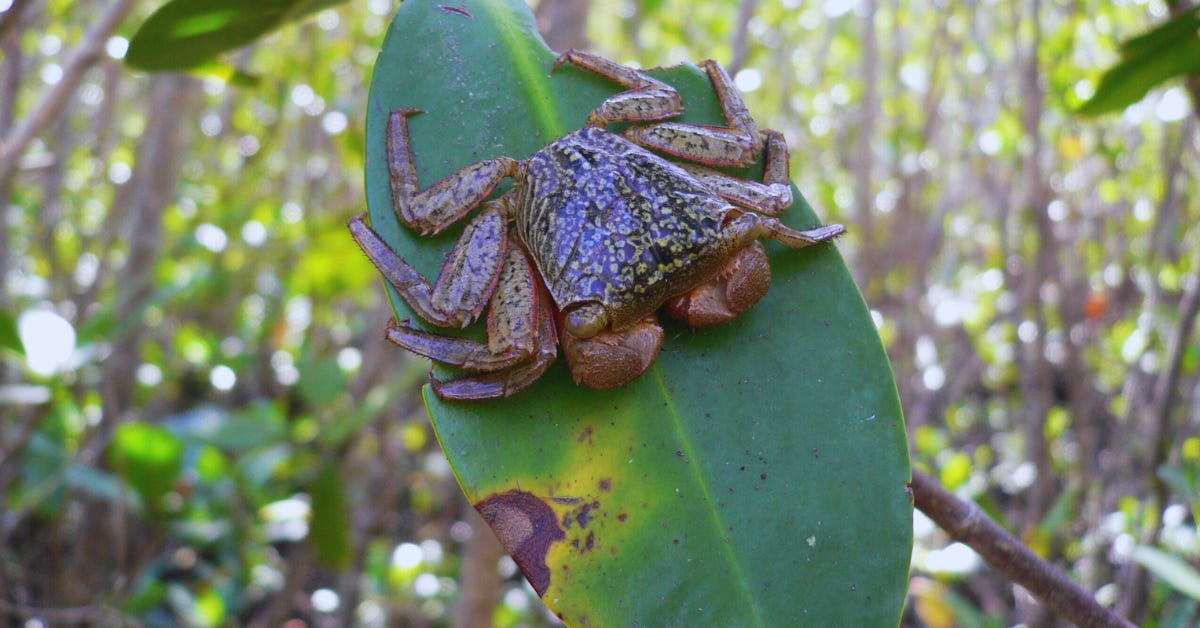Nature is full of surprises.
On my evening walk along the Florida waterfront, I stepped out onto a dock for a better look at the sunset over the estuary. With each step down the ramp, little crabs skittered to their hiding places, their tiny, armored legs making an audible *tink tink tink* against the steel.
The mangroves, which draped over the shoreline as far as I could see, had overgrown the ramp and hung low above my head. As I ducked underneath a leafy branch, casually brushing it aside, my eye caught movement in the tree.
Instantly, hairs raised on the back of my neck. I’ve been afraid of spiders for as long as I can remember, and the thought of one dropping onto my head from the tree above was horrifying!
But my curiosity was piqued, and I moved in, cautiously, to get a closer look, expecting to see a wolf spider or something similar.
To my surprise, it wasn’t a spider on the branch at all. Rather, it was one of their arthropod relatives — a crab!

About an inch long, the crab now stood still as I approached, watching me through sideways-facing eyes. The idea of little tree crabs climbing up into the foliage had never occurred to me, yet as I looked closer, I noticed half a dozen more positioned on branches all around me. Moving to a different mangrove tree, I saw crabs up there, too.
I had to investigate! Here’s what I learned about the crabs’ anatomy and behavior.
Mangrove tree crabs (Aratus pisonii) are common in coastal mangrove forests from Florida, through the Caribbean, and all the way to Brazil. They are usually about an inch long and darkly colored. Speckled patterns help them blend in to their surroundings.
When the tide is low, they venture out onto the muddy shoreline to do typical crab things, like feeding on small animals and algae, but when the tide comes in, they climb up to seek refuge among the mangrove branches.
The largest crabs claim the top branches, where their primary food — mangrove leaves — is most plentiful. Mangrove tree crabs are responsible for 80% or more of all mangrove leaf-eating, even in places where their populations are small, but mangrove leaves aren’t all that nutritious, so the crabs take every opportunity to eat animals instead, snapping up other small arthropods and scavenging carrion.
I’m amazed at all of the adaptations that allow mangrove tree crabs to occupy an arboreal niche! At a glance, they don’t look much different from the crabs we’re used to seeing skitter along the sand, but when you look closer, their bodies differ in interesting ways.
Mangrove tree crabs use their sharp, pointy legs to easily scale tree branches — note the hook shape on the end of each one.
While most crabs on the beach or underwater have forward-facing eyes on stalks, these have developed sideways-facing eyes that let them see around tree branches as they climb.
They have a flat carapace and sprawling legs that let them lay flat against the tree when strong winds blow or potential predators are near.
When threatened, mangrove tree crabs move fast. They’ve been clocked at speeds of 1 meter per second! For comparison, that’s like a person running from the goal line of a football field to the fifty yard line in the time it takes you to say, “Action!”
Sometimes, if they can’t escape from danger in the trees, mangrove tree crabs will leap to safety in the shallow water below. Plunk!
Crabs living in trees sounds unbelievable, but since that first encounter, I’ve noticed dozens and dozens of mangrove tree crabs during my walks. In fact, they’ve become one of my favorite local animals!
It’s so wonderful how a little observation and a lot of curiosity can wake you up to some remarkable quirks of nature. This is your reminder to keep exploring!







